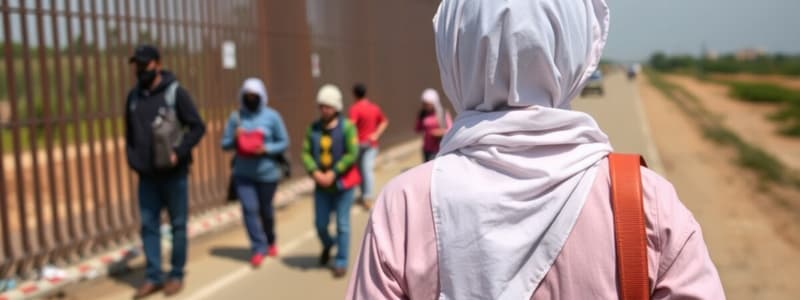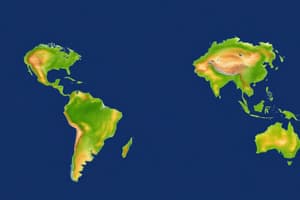Podcast
Questions and Answers
What is the definition of migration as provided by IOM?
What is the definition of migration as provided by IOM?
- The permanent relocation of individuals in search of a better life.
- The movement of people for leisure purposes.
- The movement of a person or a group across an international border or within a State. (correct)
- The seasonal movement of workers between countries.
All types of migration are considered the same and can be used interchangeably.
All types of migration are considered the same and can be used interchangeably.
False (B)
Name one type of migrant mentioned in the content.
Name one type of migrant mentioned in the content.
Refugee
The movement of people for work in different countries is often driven by __________.
The movement of people for work in different countries is often driven by __________.
Match the following terms related to migration to their definitions:
Match the following terms related to migration to their definitions:
Which of the following represents a reason for contemporary migration control?
Which of the following represents a reason for contemporary migration control?
Crossing a border without authorization is considered a crime.
Crossing a border without authorization is considered a crime.
What term is used to describe the stratification of the population into mobile upper classes and immobile underclasses?
What term is used to describe the stratification of the population into mobile upper classes and immobile underclasses?
Which of the following systems are currently operational for the management of personal data around third-country nationals?
Which of the following systems are currently operational for the management of personal data around third-country nationals?
The Entry-Exit System (EES) is already in place and operational.
The Entry-Exit System (EES) is already in place and operational.
What does VIS stand for in the context of border control systems?
What does VIS stand for in the context of border control systems?
The system that records the fingerprints of asylum seekers and irregular migrants is called ______.
The system that records the fingerprints of asylum seekers and irregular migrants is called ______.
Match the following border control systems with their functions:
Match the following border control systems with their functions:
What does the term 'crimmigration law' refer to?
What does the term 'crimmigration law' refer to?
Deportation is used solely as a punishment for criminal offenses.
Deportation is used solely as a punishment for criminal offenses.
What role do criminal law and immigration law play in society?
What role do criminal law and immigration law play in society?
The convergence of immigration control and crime control is driven by __________ shifts in governmental thinking.
The convergence of immigration control and crime control is driven by __________ shifts in governmental thinking.
Match the following technologies with their usage in border control:
Match the following technologies with their usage in border control:
Which of the following is a consequence of crimmigration law?
Which of the following is a consequence of crimmigration law?
Technology in border control has led to lesser data collection and surveillance.
Technology in border control has led to lesser data collection and surveillance.
What are the two fundamental shifts in governmental thinking mentioned in relation to crimmigration?
What are the two fundamental shifts in governmental thinking mentioned in relation to crimmigration?
Crimmigration focuses solely on border control.
Crimmigration focuses solely on border control.
What are the two main processes leading to the merging of immigration and criminal law?
What are the two main processes leading to the merging of immigration and criminal law?
The increased overlap between immigration law and criminal law includes deportation for _____ conducts.
The increased overlap between immigration law and criminal law includes deportation for _____ conducts.
Which of the following is NOT one of the three fronts of criminal policy identified by Stumpf?
Which of the following is NOT one of the three fronts of criminal policy identified by Stumpf?
Immigration enforcement resembles criminal law enforcement, but with some important similarities.
Immigration enforcement resembles criminal law enforcement, but with some important similarities.
Name one consequence of immigration law violations.
Name one consequence of immigration law violations.
Match the criminal policy fronts with their descriptions:
Match the criminal policy fronts with their descriptions:
Flashcards
Migration
Migration
The movement of people across international borders or within a state.
Immigrant
Immigrant
A person who moves from one country to another to live permanently.
Migrant
Migrant
A person who moves from one country to another to live temporarily.
Emigrant
Emigrant
Signup and view all the flashcards
Migration Control
Migration Control
Signup and view all the flashcards
Criminalisation of Migration
Criminalisation of Migration
Signup and view all the flashcards
Border Control Industry
Border Control Industry
Signup and view all the flashcards
The Border as a Location of Punishment
The Border as a Location of Punishment
Signup and view all the flashcards
Crimmigration Law
Crimmigration Law
Signup and view all the flashcards
Immigrationization of Criminal Law
Immigrationization of Criminal Law
Signup and view all the flashcards
Crimmigration Thesis
Crimmigration Thesis
Signup and view all the flashcards
Crimmigration Consequences
Crimmigration Consequences
Signup and view all the flashcards
Deportation for Criminal Conduct
Deportation for Criminal Conduct
Signup and view all the flashcards
Detention and Deportation Based on Risk
Detention and Deportation Based on Risk
Signup and view all the flashcards
Convergence of Enforcement Methods
Convergence of Enforcement Methods
Signup and view all the flashcards
Schengen Information System (SIS)
Schengen Information System (SIS)
Signup and view all the flashcards
EURODAC
EURODAC
Signup and view all the flashcards
Visa Information System (VIS)
Visa Information System (VIS)
Signup and view all the flashcards
Entry-Exit System (EES)
Entry-Exit System (EES)
Signup and view all the flashcards
European Travel Information and Authorisation System (ETIAS)
European Travel Information and Authorisation System (ETIAS)
Signup and view all the flashcards
Crimmigration
Crimmigration
Signup and view all the flashcards
Pre-emptive Approach in Immigration and Criminal Justice
Pre-emptive Approach in Immigration and Criminal Justice
Signup and view all the flashcards
Populist Punitiveness
Populist Punitiveness
Signup and view all the flashcards
Convergence of Immigration and Criminal Control
Convergence of Immigration and Criminal Control
Signup and view all the flashcards
Technology-Driven Borderscape
Technology-Driven Borderscape
Signup and view all the flashcards
AI in Migration Control
AI in Migration Control
Signup and view all the flashcards
Massive Data Collection for Border Control
Massive Data Collection for Border Control
Signup and view all the flashcards
Immigration and Crime Control as Gatekeepers
Immigration and Crime Control as Gatekeepers
Signup and view all the flashcards
Study Notes
Global Crimes (Border Criminology)
- This course, taught by Valeria Ferraris, meets Thursday and Friday from 2-4 PM.
- The course explores global crimes, focusing on border criminology.
What is Migration?
- The International Organization for Migration (IOM) defines migration as the movement of a person or group, either across international borders or within a state.
- This encompasses all types of population movements, including refugees, displaced persons, economic migrants, and those moving for family reunification.
- Migration's history is tied to industrialization, with people relocating from rural areas to cities in search of work.
- Globalization creates new migration patterns, with individuals seeking work or education in various countries (e.g., Dubai, Australia).
Words Related to Migration
- The course utilizes various terms related to migration, including:
- Highly skilled worker
- Seasonal worker
- Long-term resident
- Overstayer
- Refugee
- International protection holder
- Immigrant
- Emigrant
- Stateless person
- Asylum seeker
- Applicant for international protection
- Illegal immigrant
- Non-EU national
- Environmental migrant
- Economic migrant.
Is All Migration the Same?
- Migration categories are often used interchangeably and are indistinct.
- These terms are connected to issues of race, ethnicity, and the idea of being a "foreigner."
Understanding Mobility → Control of Mobility
- Contemporary mobility challenges state control over borders, which are central in migration management.
- Bordering practices are widespread across society, differentiating between populations: some can move freely everywhere, while some cannot.
- The stratification of populations, according to Bauman, shows an immobile underclass and a mobile upper class.
- The course highlights issues like skilled/unskilled migration and desirable/undesirable migration aspects.
- Reasons for migration – integration possibilities, relationship to class, and citizenship status.
Migration Control as a Criminological Problem
- Borders function as a location for punishment in migration control.
- Two main objections are that border crossing is not a crime and immigration enforcement is not a form of punishment.
- Criminalization of migration is a significant aspect of the issue.
- Emergence of industries, like border control systems, is also part of the problem.
- Also, penalties and loss of rights for infractions and their justifications.
Criminalization of Migration
- The concept of criminalizing migration is not new, but the modalities and reasons for doing it are changing.
- Criminalization is linked to terrorism threats and recent "criminalization of solidarity."
- Criminalization of migration means the criminalization of people's movement.
Crimmigration Thesis
- A crimmigration thesis by J.P. Stump (2006) details the interaction between immigrants, criminality, and state power.
Crimmigration Law: How and Why
- Crimmigration law merges immigration and criminal law (administrative and criminal laws).
- The course focuses, initially, on the US, then on Europe.
- The questions examined include the theoretical foundations of the merging, the merging process itself, and the merging's origins and time scale.
Crimmigration What?
- The course analyzes the effect of 1990s–2000s migration law and policy reforms in the US.
- The merging of immigration and criminal law is a result of two processes: criminalization of immigration law and immigrationization of criminal law.
- Both processes aim toward border control and crime prevention.
- Crime is currently governed through migration laws and human mobility under criminal law.
Crimmigration What? (Three Fronts of Criminal Policy)
- Stumpf identifies three fronts of criminal policy related to crimmigration:
- consequences for immigration law infractions under criminal law
- consequences for criminal convictions under immigration law
- criminal tools and procedures in immigration law
Description of Merging of Criminal and Migration Law (How)
- Migration laws and criminal laws overlap more and more.
- This shows up in aspects such as deportation for criminal conduct, immigration-related criminal offenses, detention/deportation of those considered risk factors (terrorism), and criminal law procedures resembling immigration enforcement processes, although with differences.
Some Examples
- Immigration offenses are now considered crimes.
- This has implications for migrant rights, harm levels, guilt, sentencing (deportation), and penalties against employers, airlines, homeowners, and other entities.
- Enforcement agencies such as police, FRONTEX and immigration detention agencies are now closely involved.
- Both criminal and immigration law contribute to societal control by targeting those seen as outsiders.
The Cost of Crimmigration
- Punishing criminal offenses with exclusion or deportation can be efficient but circumvent rights protections, leading to financial and operational impacts on non-citizens, families, employers, and the community.
Why Crimmigration Law?
- Criminal and migration law play a role as gatekeepers to membership in societies.
- Both laws are tools for defining who belongs or is excluded. Immigration law and criminal law play similar roles.
The Convergence of Immigration Control and Crime Control
- The convergence of immigration law/enforcement with criminal justice is made possible by governmental shifts/thinking, specifically:
- New penology (using pre-emptive and risk assessment), and
- Policy shifts that seek to take a "law and order" approach for gaining support.
The Industry of Border Control: Technology
- Advancements in technology are shaping new methods of border control, like drones, radar, X-ray technology, and large-scale biometric databases.
- AI tools enhance prediction of risks and movements.
A Massive Data Collection
- A large-scale data collection process accompanies modern technology's use in border control.
Technology-Driven Borderscape
- The EU has established databases (SIS, EURODAC, VIS, EES, and ETIAS) with third-country nationals' personal data.
- These systems aim for interoperability, allowing seamless data exchange between them.
The Industry of Border Control: Border Police
- Border policing expands beyond traditional borders (e.g. Frontex) and incorporates humanitarian roles.
- Border police functions resemble traditional police work, with interactions with other agencies (public entities, landlords, universities, and immigration enforcement).
The Industry of Border Control: Immcarceration
- Immigration detention and deportations now are part of the immigration-control industry.
The Pains
- Contemporary research suggests that the infliction of harm during migration controls represents a punitive intent and deterrence.
- This is seen through detention, deportation, imprisonment, and other penalties.
See You Next Week!
- The course will resume next week on Thursday and Friday from 2-4 PM.
Studying That Suits You
Use AI to generate personalized quizzes and flashcards to suit your learning preferences.




